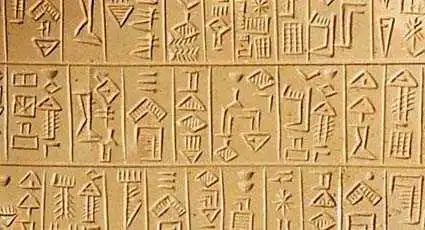
The Logics of Myth 3Basic Patterns of Creation Myths
3 Dramaturgy in creation mythsOne might wonder why it should be necessary to go through all the above definitions of stories, tales and myths, when aiming to examine the structures of cosmogony in creation myths. An alternative approach would be to extract the cosmological fragments and statements in creation myths as well as other forms of mythology, religious traditions and all kinds of tales. Then there would be no need for any analysis of the form of the stories.
In the case of creation, though, this must take the form of a story, since it consists of events taking place in a fixed order through time. No matter how rhapsodical, a cosmogony is always in the form of a story — first this happens, then that, and in almost every case one thing leads to the next, if not in an explicit order of cause and effect, so definitely in tight relations of some kind in this chain of events. Therefore, cosmogony is not meaningfully extracted from the story of it — nothing of its cosmological workings would remain.
Story-lineNow, this unavoidable story-line of any creation myth denotes that circumstances relating to how plots and stories work, the rules of dramaturgy, have influence on its form. If we are not aware of the makings of the story, its rules and circumstances, we may misinterpret the cosmology it contains. Dramaturgical ingredients of a tale may be mistaken as cosmological components or lead to a flawed understanding of them.
Seventh dayFor example, when God rests on the seventh day of creation, are we to understand that literally — so that his work on the previous days has left him fatigued? The bible seems to indicate it: "and he rested on the seventh day from all his work which he had done" (Revised Standard Version). In this monotheistic cosmology, that would imply something of a limit to his omnipotence — how many worlds would he be able to create, or how big ones, before overcome by fatigue? Another interpretation of this part of the story would be that he simply takes a pause to watch and take pride in his accomplishment. In other words, it would be a narrating way of emphasizing the magnificence of his deed.Whatever interpretation chosen, it needs to consider the workings of a story, and would not make the same sense extracted from the story concept. An even more valuable instrument is the story-based analysis in such a way that it can often point out where a myth has been corrupted or misses a part. If, in the seven day rhapsody of Genesis, God would do nothing at all on, say, the fourth day, or there would be no mentioning of that day, we could safely assume that the version of the tale we have is not the correct one — and this we surmise from the inner workings of stories, alone.
Cain's wifeThis so to speak dramaturgical method is extremely sharp and resourceful. Used on the second creation story of Genesis, it points out the strange anomaly, when Cain leaves the first family, going to the east of Eden and finding a wife. So, where did she come from? Either we are to assume, rather rudely, that the people of the time of this myth's making did not have brains enough to observe this flaw of the story, or we must conclude that the biblical version is lacking some segment or circumstance, which would solve the dilemma.
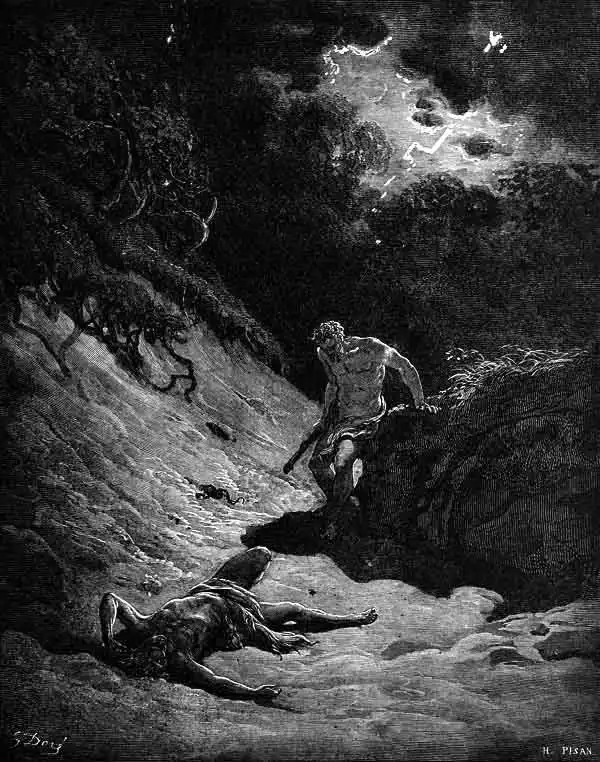 Cain kills Abel. Bible illustration by Gustave Doré, 1866. Then, where would such a missing part fit in? The story moves on nicely with Adam and Eve, all the way to when they are thrown out of the garden of Eden. So far there is, so to speak, no fourth day missing. Every character in the story has its clear role, and events take place in an orderly fashion, one thing leading to the next. But then, with the start of the fourth chapter of Genesis, the stringency of the story is somewhat lost. Now Adam knew Eve his wife, and she conceived and bore Cain, saying, "I have gotten a man with the help of the LORD." And again, she bore his brother Abel. Now Abel was a keeper of sheep, and Cain a tiller of the ground. In the course of time Cain brought to the LORD an offering of the fruit of the ground, and Abel brought of the firstlings of his flock and of their fat portions. And the LORD had regard for Abel and his offering, but for Cain and his offering he had no regard. One might wonder why God prefers one sacrifice to the other, but even more puzzling is his carefree meddling with the affairs of creatures he has just thrown out of Eden. There is nothing in the former chapter explaining what kind of a relation He now has to the human beings, his only clear link to them being Adam and Eve of his own creation.
Worship commencesWhen Cain has slain his brother and taken a wife, he founds a city and his family multiplies. Adam and Eve, on their side, have a son, Seth, who also has a son, Enosh, after which the bible states: "At that time men began to call upon the name of the LORD," as if it is only by now that a worship of their God commences.With this the fourth chapter ends, and the fifth starts with a short recapitulation, mentioning the age of Adam upon his death, and his offspring, generation after generation. This simple catalogue of generations stops only at Noah, where the next elaborate story begins.
Characters relatedThus, we have one story ending with Adam and Eve thrown out of Eden, followed by a short story about Cain slaying his brother and leaving to live the rest of his life elsewhere, thirdly and many years ahead the story about Noah commencing. The only thing linking these three stories is how their characters are related.In the story of Cain it is appalling that Adam and Eve have no roles at all in it, although it is their son slaying their other son. Would they not call upon God and demand of Him to punish Cain, and would they not ask of God to bless them with a new son in Abel's place? They would at least do something, but none is mentioned. After giving birth to Cain and Abel, nothing until Cain is gone and they give birth to another son, after which they again contribute nothing to the story. Dramaturgically, then, Adam and Eve are not at all needed in the story about Cain, as they add nothing to it but the fact that any man must have parents, which we would have surmised even if they had not been mentioned. In other words, Cain and Abel would not need to be the sons of the very first couple, since there is nothing in the story implying that this would have baring on the story, no reference to either the events in Eden or the characters of Adam and Eve in what follows. Cain slaying his brother is just as terrible, whatever generation after Adam and Eve they would belong to.
Later descendantsSo, the most readily available solution to the anomaly of Cain finding a wife elsewhere, is that Genesis has simply comprised a number of generations into one, making Cain and Abel sons of Adam and Eve, instead of descendants of a later date, when there are more people to be found on earth. Even in a myth, it is easy to comprehend that some generations back to the distant first couple of human beings can have been lost to memory. Such a skip of generations would also make it easy to see why the story is so detailed up to Cain and then so rhapsodic until Noah.
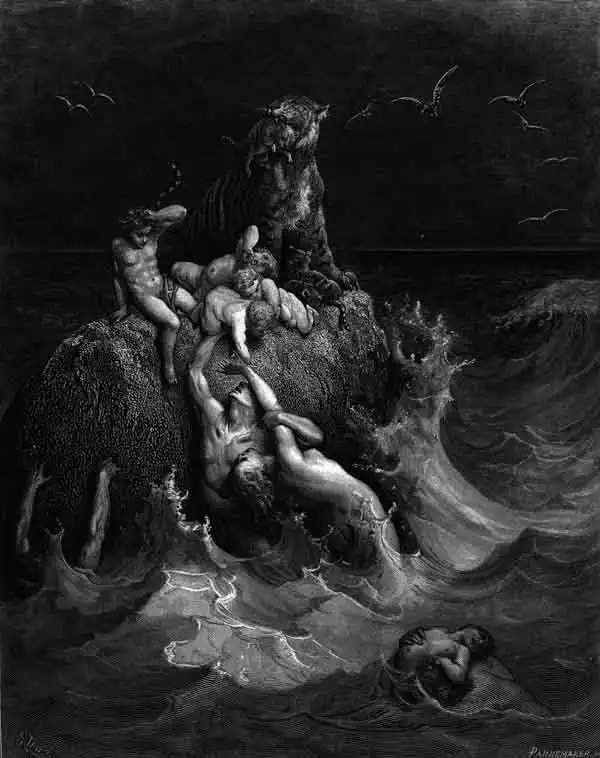 The Deluge. Bible illustration by Gustave Doré, 1866. The floodIt is additionally interesting that the story of Noah and the flood comes near to being a creation myth too, where Noah is to gather two of each species, etcetera. God must still be fatigued after his six day creation, considering that he this time lets Noah do most of the job. Since the world has already been created once, we might venture to call the story of Noah a myth of re-creation, a term fitting nicely also with the fact that this time God seems indeed to take a bit of a rest.The story of Noah has striking similarities to that of Adam — where Adam is first to name the animals, Noah preserves them from the flood, where Adam's sons people the earth, so do — anew — the sons of Noah. There is even a son of Noah condemned, although this time the son's sin is no worse than having seen his father's nakedness. Finally, after the expulsion of Noah's son, there is a quick listing of generations to come, similar to that following the fate of Cain, this time to halt at Abram.
Naming animalsAn alternative explanation, finding many parallels in myths from other cultures, is that the second creation myth of Genesis initially only dealt with the creation of the Jews, stating nothing about how people in other parts of the world were created. There are several examples of such a limited perspective to creation in other mythologies. On the other hand, Adam being allowed to name the animals after God has created them indicates the idea that this is indeed the very first man on earth — especially since we learn that it is at a much later point in time that God makes people speak with different tongues. The second creation myth in Genesis seems to state that the names Adam gives the animals are the first names they get, and that he is indeed the very first man. It is only after the exclusion from Eden, that people diversify and the Jewish tribe forms as something separate from mankind as a whole.
AristotleFor a reliable application of dramaturgy on creation myths, as well as any other myths, it is necessary to find some structural definitions and framework. Although the principles of drama and its inner logic were well established already at the time of Aristotle and his book on the subject, in the treatment of myths they would have to be reconsidered, some such principles to remain, others to change or be totally excluded.We cannot take for granted that all myths are created with a dramaturgical awareness as cunning as that of the ancient Athenians. Instead, we must — where a myth does not clearly indicate additional sophistication — find some basic rules of dramaturgy, which any myth can be expected to obey. In the case of creation myths this may become even more tricky than in a myth of adventure, since the former is an explanatory myth, thereby having a focus on something much more abstract, not to say alienated, than what is the case with most tales of heroic adventures. Therefore, I will in the following extract only such dramaturgical rules which would also apply to creation myths. It is possible that for myths of adventure, the dramaturgical structure can be made more complex and precise.
Starting pointFirst of all, a myth of creation must have a series of events with a clear starting point and a moment at which things are completed, not necessarily to the extent that the start is the very beginning of time and the completion is at the end of time, the universe and everything, but there has to be a detectible starting and stopping point in the story, whatever is assumed to come before the former and after the latter.In between the starting and stopping point of the creation myth, there has to be a series of events, meaningfully linked to each other — if not in the sense of one event naturally and directly causing the next, so in any case a relevance existing between them, a relation of sorts, a thread running through them all. When one event is followed by another, there should be some way of grasping that the two events have or will have something to do with one another.
Seven daysBoth of the above demands are clearly illustrated by the first story of creation in Genesis, where God's work is divided into seven days. The starting point seems to be the very first words: "In the beginning God created the heavens and the earth", but since the creation of heaven does not take place until day two, where he separates both the sky and the land from an original dark water, this can be questioned. Perhaps it is to be regarded as a sort of headline for the text, and God's first creative action is: "Let there be light", which also is a prerequisite for making this the very first day.The end of the story is easier to determine — the seventh day, when God pauses. His work is done, he has created the world and all of its inhabitants, including man. This is a logical finale in any creation myth — the moment where the world is made into the shape it is perceived to remain ever since. The story may very well go on, as it does in the bible, with all kinds of adventures and complications, but if the world does not change in any significant way, the period of creation is over, and so is the myth of it.
AdventureJust as with the bible, many myths which do move on beyond this point, show very clear marks of turning into separate stories, more or less intimately connected to the initial myth of creation. They are often myths or tales about ancient generations of a people, and all the hardships and adventures they have gone through — thereby coming closer to the adventure type myth than the explanatory one.To this category one might easily sort the story of Noah and the flood, in spite of its re-creation theme. Nothing significant has changed from before the flood to after it. Same world, and soon enough same sinful, weak-minded creatures peopling it. The only explanatory ingredient in the story is the rainbow, said to be created as a sort of God's signature to his promise never again to let this disaster befall on his people — and it can be discussed, by the way, how dependable this promise has proven to be, which might be the reason for the signature being of such an elusive nature. Anyway, the rainbow is not a myth, but a mythical object of cosmological kind, and not even a very prominent one in the story at that.
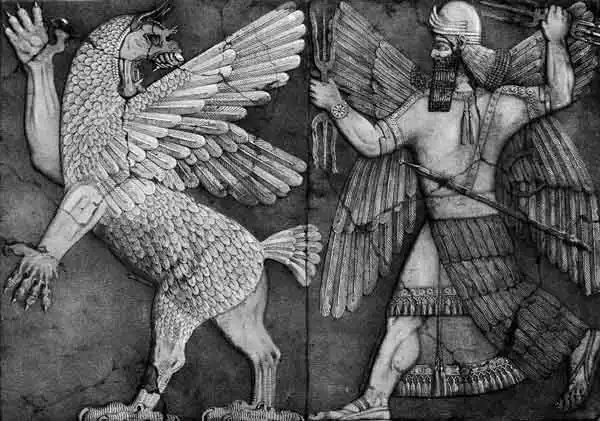 Gods of Enuma Elish in battle: Marduk chases Tiamat. Enuma ElishA creation myth also needs, as does any story, some characters, whose actions are causing the events or caused by them. The characters need not be human or of any other earthly kind — very often they are what we inadequately call gods, but they could of course just as well be objects. The Babylonian creation myth Enuma Elish starts off with two divinities, which are likely to symbolize saltwater and sweet water, a sea and a lake, which are brought into contact with one another through a third, trickster type divinity, symbolizing the rain. This is a drama between elements of nature, not really needing to be anthropomorphic, at least not in the preliminary phase, for the story to make sense.The characters — of whatever nature — need to have some recognizable relations to one another, be connected in some way, similar to how the events of the story need to be linked. In the case of a creation story there is also a need for the major characters — if not for all of them — to have some clear functions in the making of the world, or there would not have been an incentive for them to appear at all on a stage as sparse as the world in its beginning must be.
CharactersA basic rule of drama is that characters are introduced when there is a need for them, and this applies especially urgently to a story of the world's creation. Certainly, a vast number of beings can be implied in the setting of a world creation yet to take place, and this is the case in several myths — but they cannot be given any major roles, any explicit attention, if they have no parts to play in the making of the world. Also, they must be of supernatural kind, since worldly creatures would need the world to precede them.The relation between the characters and the events of a creation myth must be such, that either the characters are instrumental in the making of the world, or they are affected by it. In case of the former, they need to express some incentive, an urge or wish or ambition, leading to their creative action, by which they will reach, feel or accomplish something of significance to themselves. In case of the latter, they will be affected by the world creation to such an extent, that they will not be the same afterwards.
ChangeIn both cases it is a question of change. The characters and their situation are changing, as is eternity itself, when the world is made to appear in it. Change is the very core of drama, of any story, and it is initiated by a need, a craving for it — or a fear of it. The world may be created out of a longing for it, or accidentally out of a desperate effort to avoid it.
LonelinessIn a great number of myths, where supernatural characters are the instigators of world creation, one overwhelming motivation is evident: loneliness. They long for company, for something to end the monotony and emptiness of the eternity in which they have their abode. Genesis, again, is an excellent example of this — in both of its versions."Now the earth was formless and empty, darkness was over the surface of the deep, and the Spirit of God was hovering over the waters", states the first version, and who would not be lonely in such a desolate setting? There he hovers, God's spirit, before he suddenly exclaims: "Let there be light!" Who would not?
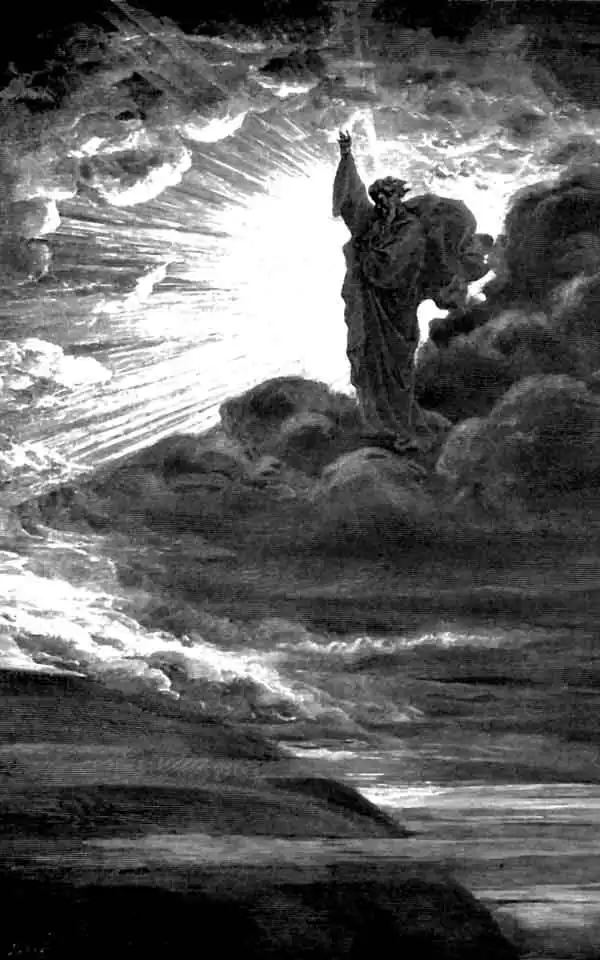 "Let there be light!" Bible illustration by Gustave Doré, 1866.
PlaymatesIt is equally obvious with what delight God is, in the second version, creating one animal after the other, presenting them to Adam and having him name them. It's like a game. God is simply having fun. That makes him all the more disappointed, when his playmates soon betray him, go behind his back. It is at the very dawning of the world, but scenes very much like it can be seen on any schoolyard during intermission. In this way, the story of the second version in Genesis is a sad one: God creates some friends — in his own image — and a wonderful playground for them all, but then he is betrayed, and suddenly alone again.Just as in any tragic drama, there are reasons for this sad outcome to be found in the behavior of the one suffering it. God has forbidden his playmates to eat the fruits of knowledge and life, which would combined make them his equals. He had made them in his image, but not the real thing. In keeping this distance to them, how could he be but deserted? In his superiority, he wanted to remain unique — all alone — so he must be just that in every other aspect too. The moral of the story would, with different characters in the roles, be highly appreciated material for Sunday school.
Closed roomThe dramaturgy of a story demands that it be a closed room, where every circumstance of any importance is present and detectible inside of it. This includes the personal expressions and motivations. If something important happens to a central character, there must be a reason for it, and the reason must be found within the story's framework. Insignificant, minor events need not have their explanations, but the major ones do — more or less outspokenly, but not less than that anyone listening to the story can figure it out, at least get a sense of it.This rule without exceptions may be understood by what dramaturgy calls the premise — at the very starting point of the drama, a lot of basics about it are established, which may be called the cosmology of the drama, its natural laws of sorts. For the audience to accept what is later to take place in it, a drama must initially establish what laws apply, what correlations have relevance, what information is or is not needed to understand it. In this way, a drama becomes a closed room, with all essential ingredients of it already present at the beginning. That is why explanations to what happens in it must always be possible to find within its setting, among its ingredients. In this sense, there can be no loose ends. In a myth portraying the drama of world creation, the same limitations apply. Dramaturgical rules of a creation myth:
NextTime-space dimensions of creation mythsThe Logics of MythBasic Patterns of Creation Myths
This article was originally written in 1999 for a seminar at the Department of History of Ideas, Lund University, as a part of my dissertation in progress on Creation Myths and their patterns of thought. Published on the web on September 6, 2001.
MENUCreation Myths Around the WorldHow stories of the beginning began.
The Meanings of MythologyTheories through history about myth and fable.
Archetypes in MythsThe mythological symbols and what they stand for.
The Logics of MythPatterns of creation.
ContactAbout Cookies
CREATION MYTHS IN DEPTHCreation in Rig Veda 10:129The paradox of origin, according to an Indian myth.
Genesis 1The first creation story of the bible scrutinized.
Enuma ElishThe ancient Babylonian creation myth.
Xingu Creation of ManThe insoluble solitude of gods and humans.
ON MY OTHER WEBSITESPsychoanalysis of MythWhat Sigmund Freud and C. G. Jung thought about myths, their origins and meanings.
Myth of CreationAn introduction to the subject of creation myths and the patterns of thought they reveal.
Cosmos of the AncientsWhat the Greek philosophers believed about the cosmos, their religion and their gods.
Life EnergyThe many ancient and modern life force beliefs all over the world explained and compared.
TaoisticTaoism, the ancient Chinese philosophy of life explained. Also, the complete classic text Tao Te Ching online.
|
 Archetypes of Mythology
Archetypes of Mythology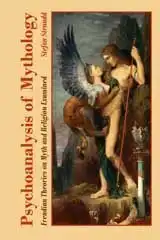 Psychoanalysis of Mythology
Psychoanalysis of Mythology Cosmos of the Ancients
Cosmos of the Ancients Life Energy Encyclopedia
Life Energy Encyclopedia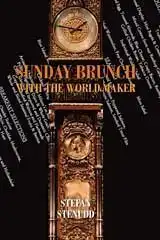 Sunday Brunch with the World Maker
Sunday Brunch with the World Maker Fake Lao Tzu Quotes
Fake Lao Tzu Quotes Stefan Stenudd
Stefan Stenudd